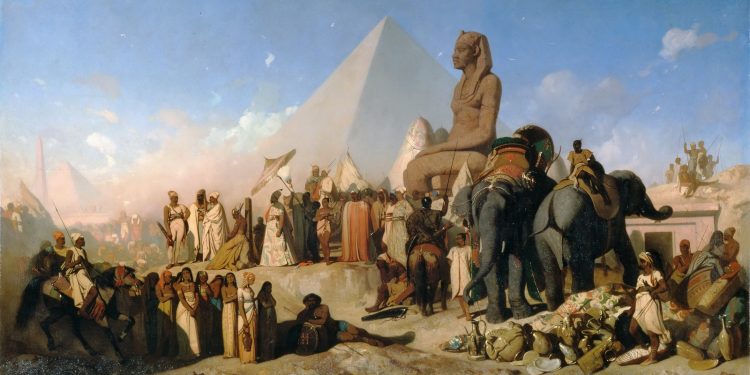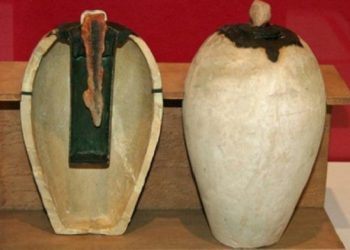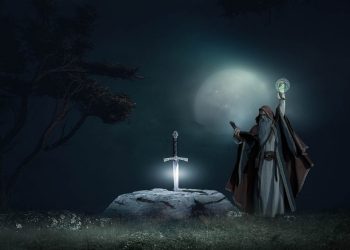In 524 BC, King Cambyses sent an army of 50,000 soldiers to enslave the city of Ammonians (Modern day Siwa in Africa). However, they never reached their destination. The entire army of 50,000 soldiers vanished into the desolate Egyptian desert.
There is no explicit mention of this lost Persian army in any ancient scriptures. Neither a single Persian or Egyptian historian nor Cambyses’ successor Darius described it in the “Behistun inscription.”
Nothing but a few bronze weapons, some human bones, and a silver bracelet has been found in the wilderness of the Sahara Desert.
What could have gone wrong? What happened to King Cambyses‘ Army?
Let’s take a look at some of the possibilities.
Sandstorm?
According to Herodotus, the famous Greek historian, after seven days of wandering into the desert, the army was hit by a cataclysmic sand storm which completely engulfed the troops and buried them under the sand.
Two Italian archeologists also believe that there is strong evidence that a sandstorm indeed struck the army.
While working in the desert, the researchers discovered a large rock with some human remains, cutlery, and weapons buried around it, indicating that some soldiers took refuge under this rock when the sandstorm hit.
However, most archeologists disagree that a sandstorm could disperse and kill 50,000 people.
Drunken Rage?
What provoked the King to send such many soldiers to march through such a hostile territory?
It all started when the priests at the oracle of the Temple of Amun announced that they did not feel any sense of obedience towards their new King, Cambyses, son of Cyrus the Great.
Cambyses was furious and decided that he would not forgive them for their mutiny. So, he sent soldiers marching through the Sahara from Thebes to put those insubordinate priests in their place.
It is presumptively a myth, but some think he ordered the troops to attack the city in a drunken rage. So, maybe they were not well equipped to cross the deadliest desert in the world.
Deviation from the Planned Route?
The red line in the map shows the actual invasion route, while the blue line shows the deviation from that route.
Some historians compare this situation with the visit of Alexander the Great to the Oracle, which was almost 200 years after this incident.
Even he took a route along the coast in the North and then turned South to reach Siwa. His course was far less complex through the desert. Historians agree that Alexander’s army could also get lost if it were not for some heavenly intrusion.
If Herodotus’ theories are true, it is still a mystery why the Persians took a far tougher route than Alexander, and that too two hundred years before? Was it a deliberate attempt to trap the army?
How much Water was Carried?
It was a journey of 50,000 soldiers through the heart of the largest desert in the world. The most basic requirement of the army was food and water.
If we suppose that the need for the water per person was 3 liters per day (keeping in mind the intense heat causing sweating and dehydration), and the journey was, let’s say, 30 days long, then 50 thousand soldiers will need 4500 tons of water at least. Still, it won’t be enough since we are not counting the animals.
The guess could not be this simple, and it looks like the lost Persian army was moved towards death by their own King.
Unfamiliarity with the Local Terrain
The Persian army consisted of people who belonged to different regions.
They were mainly Medians, Greeks, Scythians, Parthians, Egyptians, and perhaps some from the Indian region as well, which suggests that most of the soldiers and their commanders had little experience of the Egyptian desert and the horrible reality of the Great Sand Sea (which is a frightening expanse of utterly secluded desert in western Egypt).
Defeated by Petubastis III
Professor Olaf Kaper believes that the army did not disappear but was defeated. Furthermore, he believes that the final destination of the army was the Dakhla Oasis, where the Egyptian rebel leader Petubastis III resided.
He ambushed the army in the midway, defeated them, took prisoners, and eventually conquered Egypt. He was later crowned as Pharaoh in the capital, Memphis.’
Ambush
Cambyses is depicted as a mad King in the chronicles of Herodotus. He is accused of defiling and burning Pharaoh Amasis’s corpse and slaughtering a calf, Apis, which was worshipped as a God in the Egyptian Religion.
He is also accused of murdering his brother, Smerdis, which further ignited the belief in Persians that he had lost divine favor and was not worthy of keeping the crown.
Consequently, a revolt was pursued. There is a strong possibility that the army was ambushed by the renegades (rebels) on their way and was defeated.
Some also speculate that those renegades were backed by Darius, the successor of Cambyses, and he repressed their defeat and fabricated a story about the sandstorm.
Mutiny
Some speculate that there was a feeling of mistrust and betrayal among the army when they set their foot in the deserts.
King Cambyses’ deteriorating reputation and the harsh weather conditions fueled resentment among the soldiers, and they revolted. Bloodshed ensued, and those who survived fled to Dakhla oasis to join Petubastis.
The Expedition Never Happened
You will get many theories in history but not a single apparent factual reason about this lost army and its expedition.
There is a strong possibility that they started their journey in a hassle as per order by their eccentric King but abandoned the mission once they realized that odds were not in their favor and they could not survive in the deadly desert.
Desert rheumatism or Desert dermatoses?
Valley fever or desert dermatoses are common among people inhabiting the deserts or traveling through deserts for extended periods.
There is also a myth that a few days in scorching heat may have exposed soldiers to coccidiosis’s organisms, making them sick, and since there were already deep into the desert, help was unreachable.
The Majority of soldiers succumbed to death, while others, demotivated and disgruntled, dispersed towards to mainland.
What happened to King Cambyses’ army will perhaps remain a mystery for times to come.
Join the discussion and participate in awesome giveaways in our mobile Telegram group. Join Curiosmos on Telegram Today. t.me/Curiosmos











